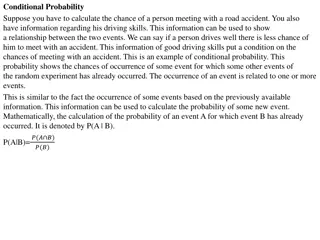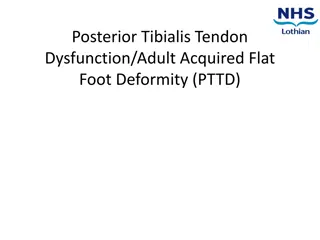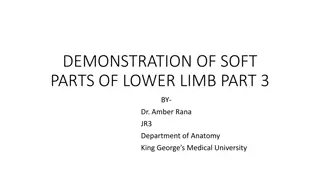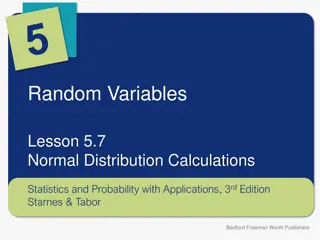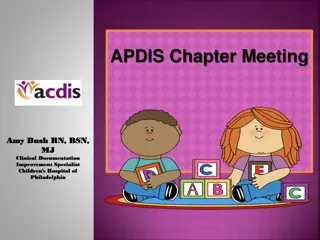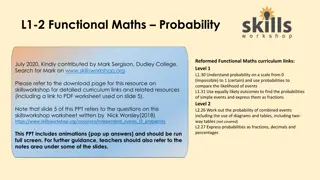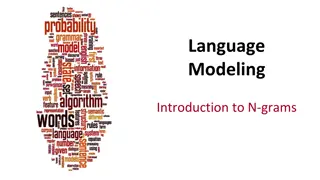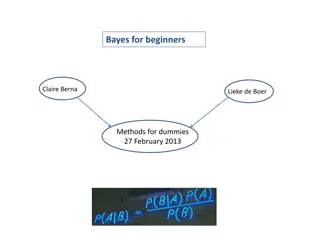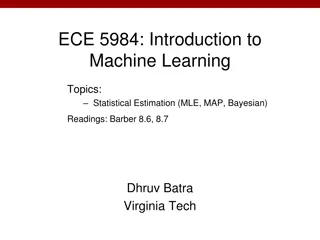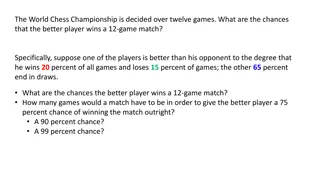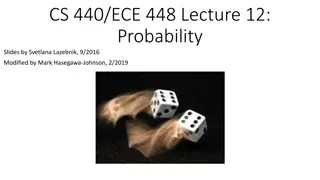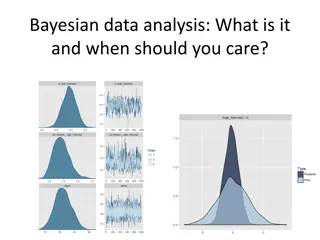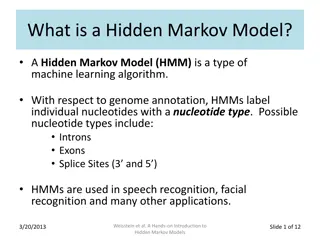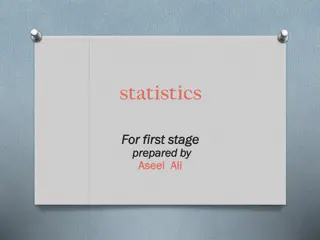Conditional Probability and Bayes Theorem
Conditional probability relates the likelihood of an event to the occurrence of another event. Theorems such as the Multiplication Theorem and Bayes Theorem provide a framework to calculate probabilities based on prior information. Conditional probability is used to analyze scenarios like the relati
1 views • 5 slides
Demonstration of Soft Parts of Lower Limb - Part 3 by Dr. Amber Rana at King George's Medical University
This presentation outlines the structures of the lateral compartment of the leg, posterior compartment of the leg, and dorsum of the foot. It includes information on boundaries, muscles, nerves, and vessels in each region, along with detailed descriptions of specific structures such as the peroneus
0 views • 15 slides
Posterior Tibialis Tendon Dysfunction (PTTD) in Adults
Posterior Tibialis Tendon Dysfunction, also known as Adult Acquired Flat Foot Deformity (PTTD), is a condition that affects the tibialis posterior tendon, leading to reduced arch support. Common causes include obesity, trauma, age, and existing health conditions. Symptoms may include ankle pain, swe
1 views • 12 slides
Demonstration of Lower Limb Soft Tissues - Part 3
This detailed demonstration by Dr. Amber Rana from King George's Medical University focuses on identifying and describing the structures of the lateral compartment of the leg, posterior compartment of the leg, and dorsum of the foot. It covers boundaries, muscles, nerves, and vessels present in each
0 views • 15 slides
Normal Distribution Calculations in Statistics
Exploring normal distribution calculations in Statistics involves calculating probabilities within intervals and finding values corresponding to given probabilities. This lesson delves into the application of normal distribution to determine probabilities of scoring below a certain level on tests an
3 views • 13 slides
Introduction to Bayesian Classifiers in Data Mining
Bayesian classifiers are a key technique in data mining for solving classification problems using probabilistic frameworks. This involves understanding conditional probability, Bayes' theorem, and applying these concepts to make predictions based on given data. The process involves estimating poster
0 views • 20 slides
Bayesian Inference with Beta Prior in Coin Toss Experiment
Suppose you have a Beta(4,.4) prior distribution on the probability of a coin yielding a head. After spinning the coin ten times and observing fewer than 3 heads, the exact posterior density is calculated. The posterior distribution is plotted and analyzed, showing how the prior influences the updat
8 views • 15 slides
Clinical Documentation Case Study: Posterior Fossa Syndrome and Mutism in Pediatric Patient
A case study of Kaye, a 3-year-old with a posterior fossa mass and obstructive hydrocephalus, highlights the importance of accurate clinical documentation. CDI queries to the physician clarified the distinction between posterior fossa mutism and syndrome, impacting coding accuracy and patient care o
4 views • 11 slides
Probabilistic Models: Examples and Solutions
This content delves into probabilistic models, focusing on computing probabilities by conditioning, independent random variables, and Poisson distributions. Examples and solutions are provided to enhance understanding and application. It covers scenarios such as accidents in an insurance company, ge
1 views • 12 slides
Probability in Functional Maths Curriculum
Explore probability concepts in functional maths, such as understanding probability scales, comparing likelihood of events, calculating probabilities of simple and combined events, and expressing probabilities as fractions, decimals, and percentages. Practice drawing probability lines, simplifying f
1 views • 8 slides
Invariance in Posterior Distributions
Exploring the insensitivity of posterior distributions to variations in prior distributions using a Poisson model applied to pancreas data. The analysis involves calculating posterior mean and standard deviation with different Gamma prior distributions. Results showcase minimal change in outcomes ac
0 views • 7 slides
Bayes Theorem in NLP: Examples and Applications
Introduction to Bayes Theorem in Natural Language Processing (NLP) with detailed examples and applications. Explains how Bayes Theorem is used to calculate probabilities in diagnostic tests and to analyze various scenarios such as disease prediction and feature identification. Covers the concept of
0 views • 13 slides
Introduction to N-grams and Language Modeling
Language modeling is essential for tasks like machine translation, spell correction, speech recognition, summarization, and question-answering. Dan Jurafsky explains the goal of assigning probabilities to sentences, computing the probability of word sequences, and applying the Chain Rule to compute
0 views • 78 slides
Bayesian Methods for Probability Estimation
Bayesian methods facilitate updating probabilities based on new information, allowing integration of diverse data types. Bayes' Theorem forms the basis, with examples like landslide prediction illustrating its application. Prior and posterior probabilities, likelihood, and Bayesian modeling concepts
1 views • 13 slides
Occipito-Posterior Position of the Fetal Head
Occipito-posterior position of the fetal head occurs when the head is in one of the oblique diameters with the occiput directed posteriorly. It can be categorized into Right Occipito-Posterior Position (ROP) and Left Occipito-Posterior Position (LOP), affecting 13% of vertex presentations. Causes in
1 views • 32 slides
Occipito-Posterior Position of the Fetal Head
Occipito-posterior position refers to the fetal head being directed towards the back of the pelvis. This positioning can occur to the right (ROP) or left (LOP) side. It occurs in 13% of vertex presentations and may be caused by factors like pendulous abdomen, pelvic brim shape, or sacral alignment.
1 views • 31 slides
Effect of Posterior Implant Restorations on Adjacent Teeth and Tissues: A Case Control Study
The study delves into the impact of posterior dental implant rehabilitation on adjacent natural teeth, exploring complications such as caries, cracks, fractures, and mobility. Factors such as proximal contact integrity, peri-implantitis effects, and occlusal load redistribution are considered. The o
0 views • 13 slides
Review of Common Algorithms and Probability in Computer Science
Exploring common quicksort implementations, algorithms with probabilities of failure, and small probabilities of failure in computer science. The content covers concepts like combinatorics, probability, continuous probability, and their applications in computer science and machine learning. Strategi
1 views • 15 slides
Decisions Under Risk and Uncertainty
Decisions under risk involve outcomes with known probabilities, while uncertainty arises when outcomes and probabilities are unknown. Measuring risk involves probability distributions, expected values, and variance calculations. Expected profit is determined by weighting profits with respective prob
0 views • 45 slides
Introduction to Bayes' Rule: Understanding Probabilistic Inference
An overview of Bayes' rule, a fundamental concept in probabilistic inference, is presented in this text. It explains how to calculate conditional probabilities, likelihoods, priors, and posterior probabilities using Bayes' rule through examples like determining the likelihood of rain based on a wet
1 views • 21 slides
Introduction to Statistical Estimation in Machine Learning
Explore the fundamental concepts of statistical estimation in machine learning, including Maximum Likelihood Estimation (MLE), Maximum A Posteriori (MAP), and Bayesian estimation. Learn about key topics such as probabilities, interpreting probabilities from different perspectives, marginal distribut
1 views • 23 slides
Bayes Classifier in Pattern Recognition
Bayes Classifier is a simple probabilistic classifier that minimizes error probability by utilizing prior and posterior probabilities. It assigns class labels based on maximum posterior probability, making it an optimal tool for classification tasks. This chapter covers the Bayes Theorem, classifica
0 views • 24 slides
The Posterior Pituitary Gland and Its Hormones
The posterior pituitary gland, a key part of the endocrine system, plays a vital role in hormone secretion. It controls the release of oxytocin and vasopressin, influencing social bonding, reproduction, and childbirth. Learn about the anatomy, function, and disorders associated with this important g
0 views • 26 slides
Probabilities in World Chess Championship Matches
The chances of a better player winning a 12-game match in the World Chess Championship can be calculated based on the probabilities of winning, losing, and drawing individual games. By expanding the expression representing the match outcomes, we find that the better player has approximately a 52% ch
2 views • 5 slides
Probability: Learning Outcomes and Examples
This content delves into the study of probability, covering topics such as representing probabilities of simple and compound events, calculating relative frequencies, multi-step chance experiments, theoretical and experimental probabilities. It explains concepts like chance experiments, sample space
0 views • 31 slides
Probability and Decision Making Under Uncertainty
Probability theory plays a crucial role in decision-making under uncertainty. This lecture delves into key concepts such as outcomes, events, joint probabilities, conditional independence, and utility theory. It explores how to make decisions based on probabilities and expected utility, highlighting
0 views • 34 slides
Posterior Thigh Compartment and Popliteal Fossa Overview
Explore the boundaries, contents, muscles, blood supply, nerve supply, and structures of the posterior thigh compartment and popliteal fossa. Study the cutaneous innervation, sciatic nerve, popliteal artery, and detailed anatomy of this region through informative images and descriptions provided by
0 views • 16 slides
Analysis of Fakes on Trial Experiment Conducted by NSW Department of Education
The NSW Department of Education conducted an experiment called "Fakes on Trial" to explore concepts of probability and experimental outcomes. The experiment involved students predicting coin toss results, calculating probabilities, and comparing observed results with theoretical probabilities. Throu
0 views • 11 slides
Insights into Eye Color Phenotypes and Probabilities
Understanding eye color phenotypes and probabilities through visual analysis of data from Ireland, Greece, and Poland. Utilizing programming techniques to create colorized scatterplots, frequency tables, and probability lists. Observations reveal how high probabilities of certain eye colors translat
33 views • 7 slides
Bayesian data analysis: What is it and when should you care?
Learn about Bayesian data analysis, Bayes theorem, Bayesian statistics, Bayes factor, and how Bayesians influence current data analysis. Understand the importance of integrating prior probabilities with new evidence to calculate posterior probabilities.
0 views • 30 slides
What is a Hidden Markov Model?
Hidden Markov Models (HMMs) are versatile machine learning algorithms used in various applications such as genome annotation, speech recognition, and facial recognition. This model assigns nucleotide types to individual nucleotides and calculates transition and emission probabilities to infer hidden
0 views • 12 slides
Predicting company performance
This content delves into the prediction of company performance through the MPAI approach to standardisation, focusing on AI modules, governance assessment, financial features, default probabilities, business continuity, and risk assessment. The MPAI-CUI workflow details the inputs, processing, and o
0 views • 12 slides
Posterior Polymorphous Membrane Dystrophy: Diagnosis and Treatment
A 38-year-old female presented with blurry vision and eye pain. After medical management failed to resolve corneal edema, Descemet stripping automated endothelial keratoplasty was performed on her left eye due to posterior polymorphous membrane dystrophy. Learn about this bilateral, nonprogressive,
0 views • 14 slides
Probability and Stats Essentials
Dive into the foundational concepts of probability theory, statistical analysis, and Bayes' Theorem through detailed slides and Excel spreadsheet examples. Explore marginal, joint, and conditional probabilities, as well as the sum and product rules in probability theory. Understand how Bayes' Theore
0 views • 8 slides
Probability Concepts
In this study material, you will learn about sample spaces, theoretical probabilities, and experimental probabilities. Discover the basics of probability experiments, outcomes, and event sets. Explore the calculation of possible outcomes in various scenarios. Delve into the theoretical probabilities
0 views • 22 slides
Posterior Circulation Aneurysms Overview
Posterior circulation aneurysms account for 15% of intracranial aneurysms, primarily affecting females in their fifth and sixth decades of life. They can manifest as saccular, fusiform, or dissecting types, with common locations including the basilar apex, origins of various arteries, and the basila
0 views • 38 slides
Physiology of Hormones Secreted by the Posterior Pituitary Gland
Explore the functions of the hormones oxytocin and antidiuretic hormone (ADH) secreted by the posterior pituitary gland. Learn about their roles in uterine contractions, milk secretion, blood pressure regulation, and water reabsorption. Understand conditions like hypopituitarism and gonadotropins di
0 views • 12 slides
Understanding Posterior Pituitary Hormones and Related Disorders
Explore the physiology of posterior pituitary hormones such as oxytocin and vasopressin, their functions in the body, and disorders like hypopituitarism and gonadotropin disorders. Learn how these hormones affect processes like labor, milk ejection, and blood pressure regulation.
0 views • 12 slides
Understanding Sample Space, Events, and Probabilities in Statistics
Learn about the sample space, simple events, events, assigning probabilities, classical probability formula, and rolling a die in statistics. Explore the concept of outcomes, probabilities, and distributions in statistical experiments.
1 views • 14 slides
Bayesian Classifiers in Data Mining
Learn about Bayesian Classifiers and their application in data mining, including Nave Bayes Classifier, Bayes Theorem examples, and using Bayes Theorem for classification. Understand how to estimate probabilities and compute posterior probabilities for classification problems.
0 views • 16 slides
